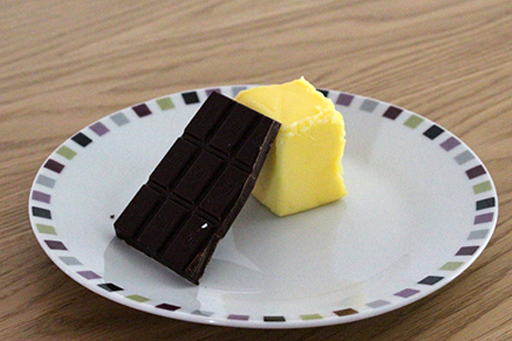3.3 Butter and chocolate
Natural fats, such as butter, are made up of a mix of triacylglycerols with different lengths of tail. And, like the number of kinks, the length of the tail also affects the melting temperature (Figure 9).
When you first take butter out of the fridge, it is very hard. But, as it begins to warm up, the triacylglycerols with the lowest melting temperatures melt first. Then, as the temperature increases further, those with slightly higher melting temperatures change from solid to liquid. So, over a range of temperatures, butter is neither completely solid nor a runny liquid. It is a mix of solid triacylglycerols in a matrix of a thick liquid made up of the triacylglycerols with the lower-melting temperatures. So, as butter warms up, it becomes easier to spread.
Spreadable ‘butters’ have added vegetable oils which have bent tails and are liquid at fridge temperatures. So the spreads containing them are spreadable straight from the fridge.
Chocolate is made from cocoa, cocoa butter and sugar. Cocoa butter comprises very few different types of triacylglycerol molecules, with similar melting temperatures. So it has quite a sharp, well-defined melting temperature. In fact, the molecules can pack together in several different ways. One of these forms melts at 33.8 °C. Thus it melts in your mouth (36.9 °C) but not in your hand, which is usually cooler. This form is also smooth and glossy. To make it solidify in this form, the melted chocolate is cooled and kept at just below 33.8 °C, while being stirred so that the fat crystallises into very small crystals. This gives chocolate its velvety texture.
If chocolate is subject to fluctuations in temperature, a bloom develops on the surface. This is caused by the fat solidifying in a different crystalline form.

